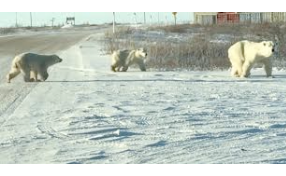Great article via Atlas Obscura….
The holding facility helps bears and people safely coexist in the remote northern town.
ON OCTOBER 4, 2022, CHANTAL Cadger Maclean, a conservation officer in Churchill, Canada, got a call: A polar bear had broken into someone’s shed on the edge of town. A teenage female, she had been circling the town’s borders for a few days trolling for food. But now Maclean and several other members of Churchill’s Polar Bear Patrol team found her standing in the shed’s doorway, munching away. This was a bad development. “Unfortunately, that bear is going to associate buildings with food rewards from now on,” says Maclean—which could lead her to people’s homes. “That means it is immediately classified as a bear we need to chemically immobilize and put into the polar bear holding facility.”
Immobilizing a 500-pound animal that can run on uneven terrains or hide among rocks takes a joint land and air effort. Hanging out off the side of the helicopter with a dart gun, Maclean’s work partner Ian van Nest, gave the ivory fugitive a shot of telazol, a quick-acting anesthetic. The on-the-ground team was ready with trucks and ATVs, but the bear got out of reach. “It took two-ish minutes for this bear to feel the effects of that drug,” says Maclean, but she managed to get onto the other side of a big berm where no vehicles could reach her. The team had to retrieve the problem girl on foot using a “polar bear stretcher,” essentially a massive board. “Seven of us carried this 500-pound bear over the berm and put it into the back of our truck,” says Maclean. “And then we drove it to the polar bear holding facility.”
That’s just another day in polar bear country. A frontier settlement founded for fur trading in 1717, Churchill sits smack in the middle of the “polar bear highway”—the natural path the animals take to get onto the sea ice every year. Located on the shore of Hudson Bay, Churchill has around 850 human residents and about the same number of bears roaming around. During the winter, the bears live on the frozen bay, hunting seals. But once the ice melts in July, they move onto land where food is scarce. “They live off the fat stores they accumulated over winter while eating seals’ blubber,” explains Rachel Sullivan-Lord, a marine biologist and expedition leader with Natural Habitat Adventures, a company that operates polar bear tours in the area. “Towards the end of November, they come to shore, waiting for the bay to freeze. By then they’ve been without hunting opportunities for several months, so they are starving. They’ll use any chance to get food.”
That annual passage makes Churchill a unique place for tourists to watch the Kings of the Arctic in their natural habitat—so up close and personal that the creatures come up to the Tundra Lodge, a seasonal wildlife-watching hotel, and stand up on their hind legs to peek at the people inside. But it also makes Churchill a dangerous place to live. Maclean remembers a recent call she got when a bear was pounding on a woman’s window at 5 a.m. in the morning. “It’s the worst place for a town to be,” she says. “Today, we would never put a town here.”
Read more at ATLAS OBSCURA




